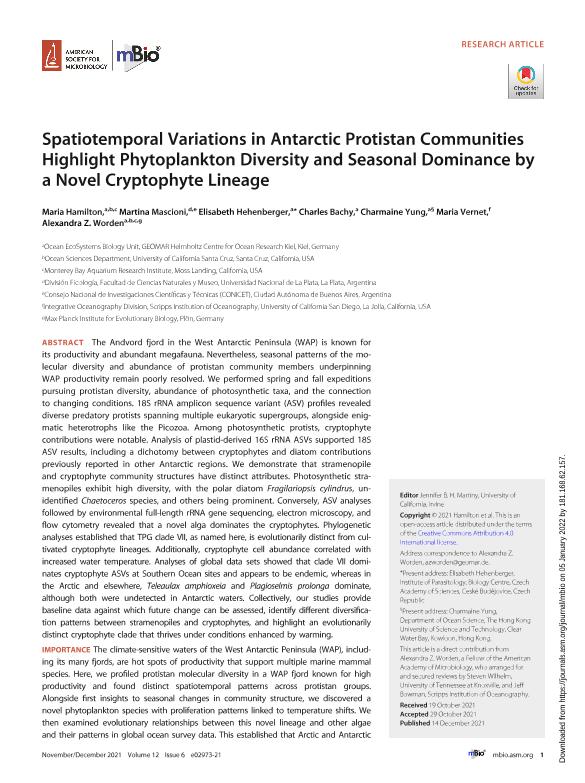Mostrar el registro sencillo del ítem
dc.contributor.author
Hamilton, Maria
dc.contributor.author
Mascioni, Martina

dc.contributor.author
Hehenberger, Elisabeth
dc.contributor.author
Bachy, Charles
dc.contributor.author
Yung, Charmaine
dc.contributor.author
Vernet, Maria
dc.contributor.author
Worden, Alexandra Z.
dc.date.available
2022-08-09T02:10:04Z
dc.date.issued
2021-12
dc.identifier.citation
Hamilton, Maria; Mascioni, Martina; Hehenberger, Elisabeth; Bachy, Charles; Yung, Charmaine; et al.; Spatiotemporal Variations in Antarctic Protistan Communities Highlight Phytoplankton Diversity and Seasonal Dominance by a Novel Cryptophyte Lineage; American Society for Microbiology; mBio; 12; 6; 12-2021; 1-23
dc.identifier.uri
http://hdl.handle.net/11336/164644
dc.description.abstract
The Andvord fjord in the West Antarctic Peninsula (WAP) is known for its productivity and abundant megafauna. Nevertheless, seasonal patterns of the molecular diversity and abundance of protistan community members underpinning WAP productivity remain poorly resolved. We performed spring and fall expeditions pursuing protistan diversity, abundance of photosynthetic taxa, and the connection to changing conditions. 18S rRNA amplicon sequence variant (ASV) profiles revealed diverse predatory protists spanning multiple eukaryotic supergroups, alongside enigmatic heterotrophs like the Picozoa. Among photosynthetic protists, cryptophyte contributions were notable. Analysis of plastid-derived 16S rRNA ASVs supported 18S ASV results, including a dichotomy between cryptophytes and diatom contributions previously reported in other Antarctic regions. We demonstrate that stramenopile and cryptophyte community structures have distinct attributes. Photosynthetic stramenopiles exhibit high diversity, with the polar diatom Fragilariopsis cylindrus, unidentified Chaetoceros species, and others being prominent. Conversely, ASV analyses followed by environmental full-length rRNA gene sequencing, electron microscopy, and flow cytometry revealed that a novel alga dominates the cryptophytes. Phylogenetic analyses established that TPG clade VII, as named here, is evolutionarily distinct from cultivated cryptophyte lineages. Additionally, cryptophyte cell abundance correlated with increased water temperature. Analyses of global data sets showed that clade VII dominates cryptophyte ASVs at Southern Ocean sites and appears to be endemic, whereas in the Arctic and elsewhere, Teleaulax amphioxeia and Plagioselmis prolonga dominate, although both were undetected in Antarctic waters. Collectively, our studies provide baseline data against which future change can be assessed, identify different diversification patterns between stramenopiles and cryptophytes, and highlight an evolutionarily distinct cryptophyte clade that thrives under conditions enhanced by warming. IMPORTANCE The climate-sensitive waters of the West Antarctic Peninsula (WAP), including its many fjords, are hot spots of productivity that support multiple marine mammal species. Here, we profiled protistan molecular diversity in a WAP fjord known for high productivity and found distinct spatiotemporal patterns across protistan groups. Alongside first insights to seasonal changes in community structure, we discovered a novel phytoplankton species with proliferation patterns linked to temperature shifts. We then examined evolutionary relationships between this novel lineage and other algae and their patterns in global ocean survey data. This established that Arctic and Antarctic cryptophyte communities have different species composition, with the newly identified lineage being endemic to Antarctic waters. Our research provides critical knowledge on how specific phytoplankton at the base of Antarctic food webs respond to warming, as well as information on overall diversity and community structure in this changing polar environment.
dc.format
application/pdf
dc.language.iso
eng
dc.publisher
American Society for Microbiology

dc.rights
info:eu-repo/semantics/openAccess
dc.rights.uri
https://creativecommons.org/licenses/by-nc-sa/2.5/ar/
dc.subject
ANTARCTIC FJORDS
dc.subject
COMMUNITY STRUCTURE
dc.subject
PHYTOPLANKTON DIVERSITY
dc.subject
PROTISTS
dc.subject
SOUTHERN OCEAN
dc.subject.classification
Bioquímica y Biología Molecular

dc.subject.classification
Ciencias Biológicas

dc.subject.classification
CIENCIAS NATURALES Y EXACTAS

dc.title
Spatiotemporal Variations in Antarctic Protistan Communities Highlight Phytoplankton Diversity and Seasonal Dominance by a Novel Cryptophyte Lineage
dc.type
info:eu-repo/semantics/article
dc.type
info:ar-repo/semantics/artículo
dc.type
info:eu-repo/semantics/publishedVersion
dc.date.updated
2022-08-03T18:10:10Z
dc.identifier.eissn
2150-7511
dc.journal.volume
12
dc.journal.number
6
dc.journal.pagination
1-23
dc.journal.pais
Estados Unidos

dc.description.fil
Fil: Hamilton, Maria. University Of California At Santa Cruz.; Estados Unidos. Ocean Ecosystems Biology Unit, Geomar Helmholtz Centre; Alemania. Monterey Bay Aquarium Research Institute; Estados Unidos
dc.description.fil
Fil: Mascioni, Martina. Universidad Nacional de La Plata. Facultad de Ciencias Naturales y Museo. División Ficología; Argentina. Consejo Nacional de Investigaciones Científicas y Técnicas. Centro Científico Tecnológico Conicet - La Plata; Argentina
dc.description.fil
Fil: Hehenberger, Elisabeth. Ocean Ecosystems Biology Unit, Geomar Helmholtz Centre; Alemania
dc.description.fil
Fil: Bachy, Charles. Geomar-Helmholtz Centre for Ocean Research Kiel; Alemania
dc.description.fil
Fil: Yung, Charmaine. Geomar-Helmholtz Centre for Ocean Research Kiel; Alemania
dc.description.fil
Fil: Vernet, Maria. University of California at San Diego. Scripps Institution of Oceanography; Estados Unidos
dc.description.fil
Fil: Worden, Alexandra Z.. Geomar-Helmholtz Centre for Ocean Research Kiel; Alemania. Max Planck Institute For Evolutionary Biology; Estados Unidos. Monterey Bay Aquarium Research Institute; Estados Unidos. University Of California At Santa Cruz.; Estados Unidos
dc.journal.title
mBio
dc.relation.alternativeid
info:eu-repo/semantics/altIdentifier/url/https://journals.asm.org/doi/10.1128/mBio.02973-21
dc.relation.alternativeid
info:eu-repo/semantics/altIdentifier/doi/http://dx.doi.org/10.1128/mBio.02973-21
Archivos asociados
